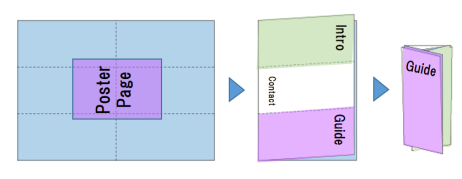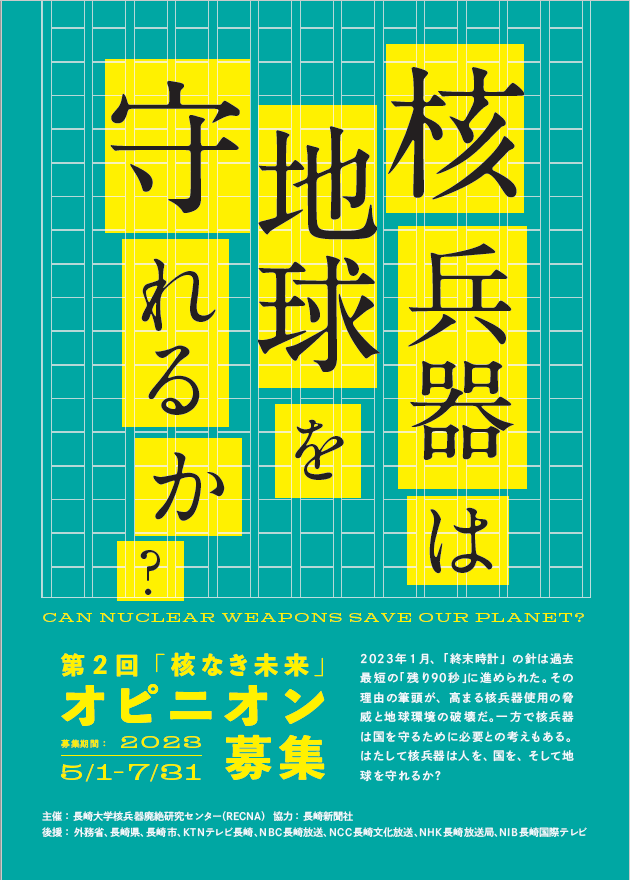Vol.6, Issue 1 of Journal for Peace and Nuclear Disarmament (J-PAND) is now available online. There are 15 open access articles. In the issue, we focus on the future of strategic stability by seeking to clarify profound challenges to the concept while also offering novel scholarly as well as policy-relevant approaches to better understanding and mitigating the risks of instability.
NEWSNEWS
A Guide to the World’s Fissile Material Inventory June 2023
“A Guide to the World’s Fissile Material Inventory June 2023” has been released! Please click on the thumbnail images below and download the pdf guide and poster.

|
Guide to the World’s |
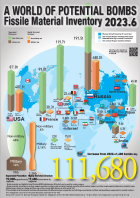
|
|
How to make leaflets:
Print the English Guide (PDF) for making leaflets on both sides of A3 paper, and fold it in two then in three.
|
>> Previous editions can be downloaded from here.
“World’s Fissile Material Data” 2023 [All Lists]
The 2023 World’s Fissile Material Data have been published. Please click on the following thumbnail images and download the pdf posters.
| Japanese | English | Korean | |
| Jun. 2023 | 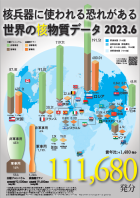 |
 |
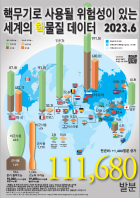 |
The special feature of this year’s map is that the total fissile material inventory, which decreased last year, has once again increased due to an increase in the amount of separated plutonium. The total inventory of HEU was 1,260 tons, equivalent to 19,680 warheads (an increase of 6 tons or about 80 warheads from last year), but this is due to a difference in the way the figures for “Other Non-nuclear Weapon Countries” are treated, and is not a substantial increase. However, the overall rising trend in separated plutonium continues, with an increase in plutonium for civilian use (mainly in France), bringing the total inventory to 552 tons, equivalent to 92,000 warheads (an increase of 8 tons or about 1,400 warheads from last year). As a result, the total inventory amount increased to equivalent to 111,680 warheads, an increase of around 1,480 warheads from last year (110,200 warheads).
◆ “A Guide to the World’s Fissile Material Inventory June 2023” Released!
Please access here.
◆ The two images to the right can be enlarged by clicking on them. You can also view and download the following PDF versions.
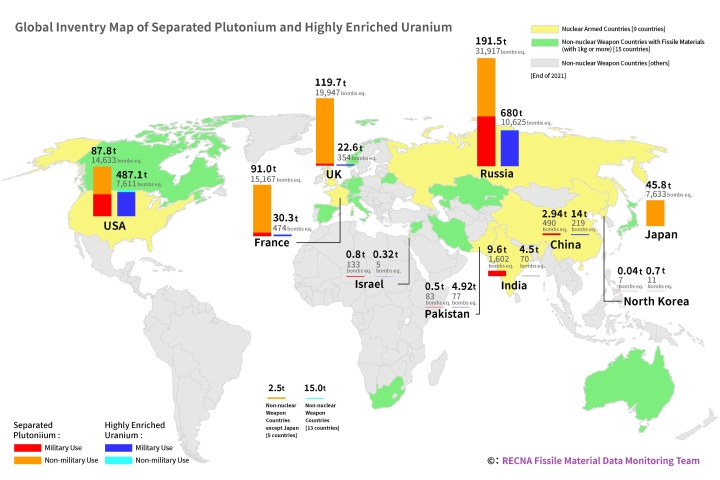 ・The 2023 Global Inventory Map of Fissile Material (PDF)
・The 2023 Global Inventory Map of Fissile Material (PDF)
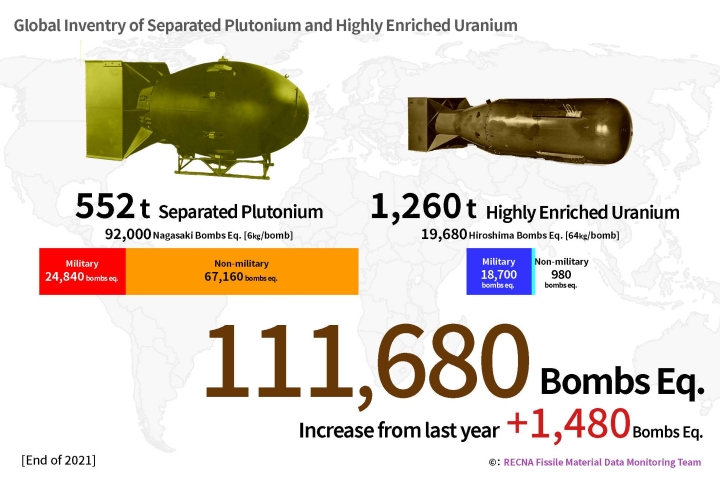 ・The 2023 Global Inventory of Fissile Material (PDF)
・The 2023 Global Inventory of Fissile Material (PDF)
◆ You can see the original data of the map from the following links.
・Global Inventory of Separated Plutonium
・Global Inventory of Highly Enriched Uranium
◆ You can see previous “World’s Fissile Material Data” from [All Lists].
◆ The 2023 World’s Nuclear Warheads Data have been published too.

“World’s Nuclear Warheads Data” 2023 [All Lists]
The 2023 World’s Nuclear Warheads Data have been published. Please click on the following thumbnail images and download the pdf posters.
| Japanese | English | Korean | |
| Jun. 2023 | 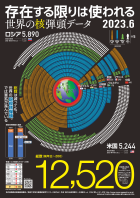 |
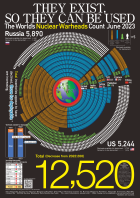 |
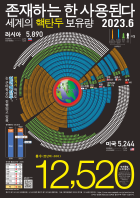 |
◇ “A Guide to the World’s Nuclear Warheads Count June 2023” Released!
Please access here.
◇ You can see previous “World’s Nuclear Warhead Data” from [All Lists].
◆ The 2023 World’s Fissile Material Data have been published too.

Calls for submissions! [JPN]
2nd Essay Contest on a “Nuclear Weapons Free Future”
The Research Center for Nuclear Weapons Abolition, Nagasaki University (RECNA), with the support of the Nagasaki Shimbun, invites youth between the ages of 16 and 29 to submit an essay on a “Nuclear Weapons Free Future.”
In January 2023, the “Doomsday Clock” of the Bulletin of the Atomic Scientist was reset to 90 seconds to midnight, the closest ever to doomsday. The Bulletin did this because of the growing threat of the use of nuclear weapons and the ongoing destruction of the global environment. There are people who argue that nuclear weapons are crucial for national security. But can nuclear weapons really save humans, nations, and the planet?
Awards will be given for outstanding essays on the theme of a “Nuclear Weapons Free Future” taking into consideration the sub-theme of the supposed role of nuclear weapons in national security, the survival of human civilization and the health of the global environment. We look forward to reading your thoughts and innovative ideas.
Entries will be divided into two groups: youth aged 16 to 19 (Under 20) and youth aged 20 to 29 (Under 30). Awards will be given to outstanding essays and there will be one grand prize winner for each age group. The two winning essays will be published in the Nagasaki Shimbun newspaper and the winning authors will be invited to participate in the award ceremony in Nagasaki on Saturday, September 23rd, 2023. If the winner resides in Japan, she/he will be invited to Nagasaki to participate in person. If the winner resides overseas, he/she will be invited to participate in the award ceremony online.
| ELIGIBILITY |
|---|
| • Under-20 (Ages between 16 and 19), Under-30 (Ages between 20 and 29) as of July 31, 2023. |
| • Any residence or nationality is welcome. |
| APPLICATION |
|---|
| Please submit the following documents in PDF format by e-mail to opinion@ml.nagasaki-u.ac.jp |
| 1. Application [form] * For download |
| 2. Your Essay (Essays should be about 1000 words, in English, and must be original and unpublished. Give your essay an appropriate title.) |
| SUBMISSION DEADLINE |
|---|
| July 31, 2023 |
| You will receive a notice of receipt approximately one week after submission. If you do not receive a notice please contact us at the contact information below. |
| * Please note that applications will not be accepted at the contact e-mail address. |
| ABOUT THE PRIZE |
|---|
| For Youth Under-30: |
| • The grand prize winner will receive a commemorative plaque, prize money of 50,000 yen, and, for a winner who resides in Japan, an invitation to the award ceremony in Nagasaki. (A winner who resides outside Japan will be invited to participate online.) A Nagasaki Peace Tour will be arranged for those who wish to participate. |
| • The second prize winner will receive a commemorative plaque and prize money of 30,000 yen. |
| For Youth Under-20: |
| • The grand prize winner will receive a commemorative plaque, prize money of 30,000 yen, and, for a winner who resides in Japan, an invitation to the award ceremony in Nagasaki. (A winner who resides outside Japan will be invited to participate online.) A Nagasaki Peace Tour will be arranged for those who wish to participate. |
| • The second prize winner will receive a commemorative plaque and prize money of 10,000 yen. |
| AWARD SELECTION AND ANNOUNCEMENT |
|---|
| Two grand prize winners and two second prize winners will be selected after strict screening by the selection committee. The committee members are: |
| • Yuichi SEIRAI, Akutagawa Award-winning author (Chair) |
| • Gregory KULACKI, Visiting Fellow of RECNA (Chair of the English Review Subcommittee) |
| • Yoshiki YAMADA, Editorial Director, Nagasaki Shimbun newspaper, visiting professor of RECNA (Vice chair) |
| • Keiko NAKAMURA, Associate Professor of RECNA (Vice chair) |
| • Mei KOJIMA, NHK (Japan Broadcasting Corporation) Nagasaki, reporter |
| • Tatsujiro SUZUKI, Vice Director of RECNA, professor |
| • Sumiko HATAKEYAMA, Co-president of Peace Boat |
| • Ruiko MATSUNAGA, peace activist |
| SCREENING CRITERIA |
|---|
| Your Essay will be evaluated on the following criteria: |
| (1) Clarity, (2) Logical consistency, (3) Factual content, (4) Creativity and originality, (5) Expressiveness |
| ANNOUCEMENT |
|---|
| The results will be announced in the Award Ceremony. |
| Time and Date: Saturday, September 23, 2023, 1-2 p.m. |
| Venue: Nagasaki University (https://www.nagasaki-u.ac.jp/en/) |
| The Grand Prize-winning essays will be published in full in the Nagasaki Shimbun newspaper at a later date. All winning essays will be published on the RECNA website. |
| * The copyright of the submitted essays belongs to entrant, but the organizer (RECNA) holds secondary use (publication online or paper format, etc.) right of the winning essays. |
| Sponsored by: the Research Center for Nuclear Weapons Abolition, Nagasaki University (RECNA) |
| Supported by: Nagasaki Shimbun Newspaper |
| Nominal support organizations: Nagasaki Prefecture, Nagasaki City, NHK (Japan Broadcasting Corporation) Nagasaki, KTN (Television Nagasaki Co.,Ltd.), NBC (Nagasaki Broadcasting Company), NCC(Nagasaki Culture Telecasting Corporation), NIB (Nagasaki International Television Broadcasting, Inc.) |
* This project is funded by a donation for the Research Center for Nuclear Weapons Abolition, Nagasaki University (RECNA).
| Contact |
|---|
|
Research Center for Nuclear Weapons Abolition, Nagasaki University (RECNA) TEL: +81-95-819-2164 E-mail: recna_staff@ml.nagasaki-u.ac.jp Website: https://www.recna.nagasaki-u.ac.jp/recna/en-top |
